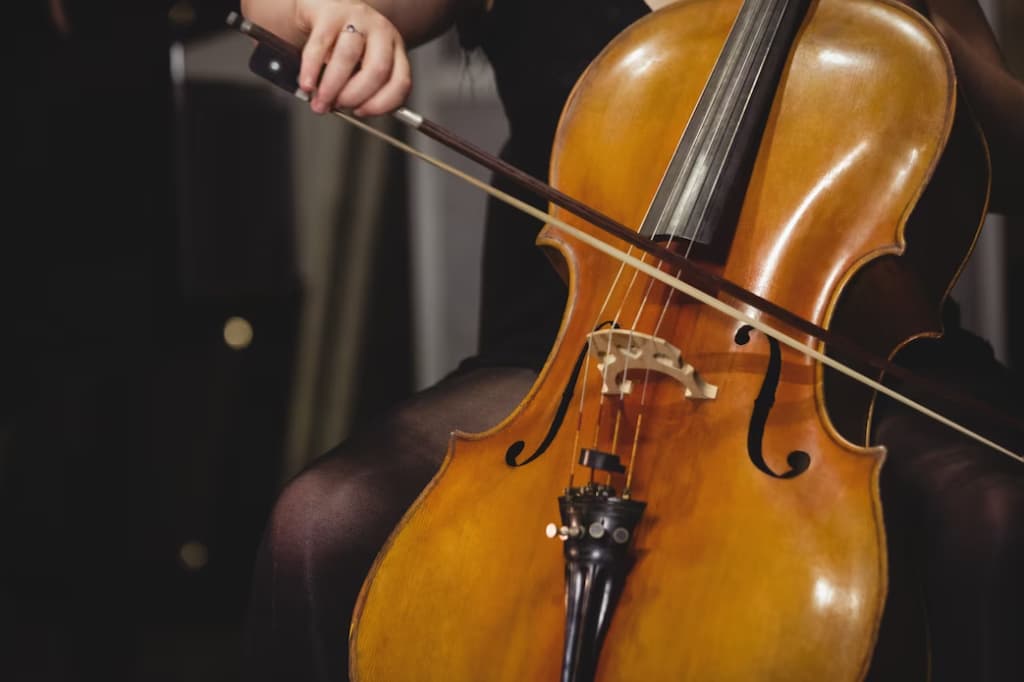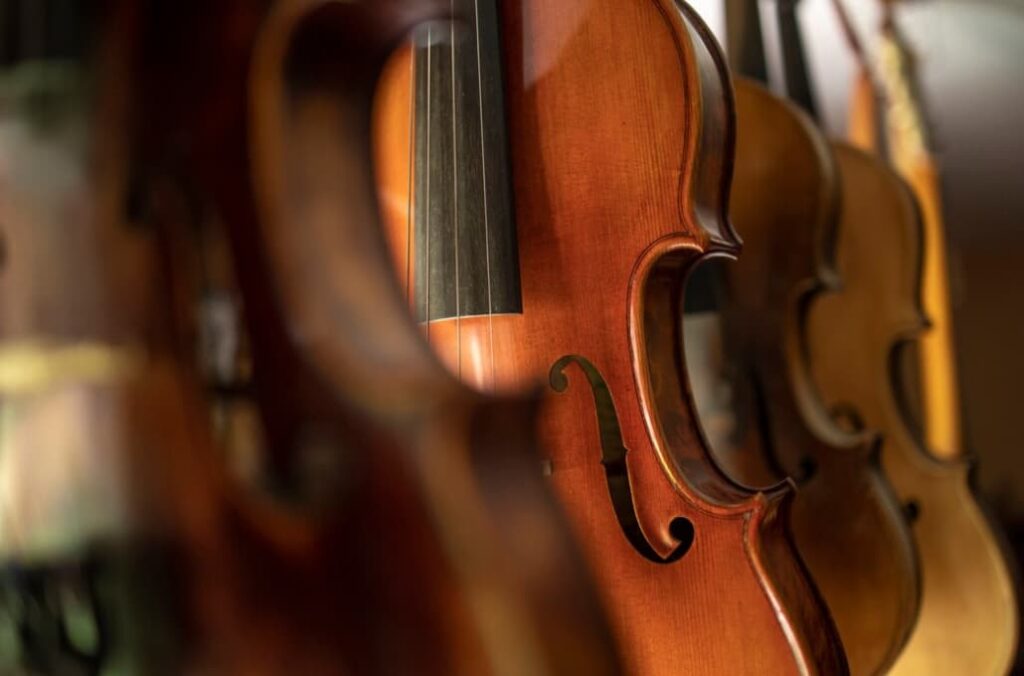Having examined various Forms in Western Classical Music (WCM), we now turn to explore the array of Genres and Styles that constitute the tapestry of WCM. It’s important to recognize that throughout musical evolution, composers have progressively embraced greater artistic liberty. Such creative expansion sometimes led them to diverge from established styles.
Orchestral and Chamber Music in Western Classical Music
In Western Classical Music, compositions are generally categorized as either ‘Orchestral’ or ‘Chamber Music.’ Orchestral pieces are executed by a large ensemble with potentially multiple musicians playing the same instrument, encompassing a diverse range of instruments. Conversely, Chamber Music is characterized by a smaller ensemble with typically one performer per instrument. The term’s origin is steeped in history, reflecting the intended setting and purpose of each genre: orchestral music was crafted for public performances, while chamber music originated as intimate performances in the private chambers of the nobility, who were often patrons of the composers. Due to its intimate nature and smaller ensemble size, Chamber Music is also known as Ensemble Music.
Other classifications include ‘Instrumental’ for solo instrumental pieces and ‘Choral’ for vocal ensembles or choirs. The subsequent sections will provide an overview of various ‘Styles’ within these broad genres.
The Concerto Genre in Western Classical Music
The Concerto is a significant orchestral genre featuring a single solo instrument, such as the piano, violin, cello, or flute, accompanied by an orchestra and typically structured in three movements. The dynamic relationship between the soloist and the orchestra is the hallmark of a Concerto, drawing parallels to the ‘jugalbandi’ of Indian Classical Music. Concertos have endured through the ages, offering a platform for soloists to display their technical prowess and interpretative depth.
Although there’s no visual recording from 1929, the timeless appeal of Concerto music is evident in its use in various films. It has graced the soundtrack of David Lean’s 1945 ‘Brief Encounter’, Billy Wilder’s 1955 ‘The Seven Year Itch’ featuring the iconic scene with Marilyn Monroe, and Clint Eastwood’s 2010 ‘Hereafter’, underscoring the enduring nature of classical music across generations.
Conventional concertos have the first movement in Sonata Form, the second may be sonata or free-flowing, while the finale is typically a Rondo or simply a ‘Theme with Variations’.
The Structure and Evolution of the Symphony
A Symphony is a cornerstone of Western Classical Music, typically a multi-movement orchestral composition, often with four or five sections. Symphonies are renowned for their longevity in the classical repertoire and their widespread appeal. The structure of a standard symphony is generally as follows:
- The opening movement is brisk and robust, introducing a strong thematic presence, usually crafted in the Sonata Form;
- The second movement provides a contrast with a slower tempo, often reflective, somber, or solemn. It may be structured as a Sonata, Rondo, or Theme with Variations;
- The third movement, traditionally a Minuet or a Scherzo, offers a moderate pace. The Minuet was originally designed for dance; the Scherzo later became more prevalent with its quicker tempo. Both typically follow the Ternary Form (ABA);
- The final movement serves as the climax, fast-paced, often in the Sonata or Rondo form, bringing the Symphony to a powerful conclusion.
It’s common to see the second and third movements interchanged. Beethoven, in his innovative approach, further transformed the symphonic form by incorporating a choir in the ‘Ode to Joy’ in the finale of his 9th Symphony.
The full force of the orchestra in a Symphony can be profoundly moving, offering an experience that, if it fails to stir the soul, one might say a piece of that soul is absent.

The Sonata: A Multifaceted Instrumental Genre
The Sonata, a foundational genre within Western Classical Music, is an instrumental composition typically for a solo instrument, such as the piano, or a duo, like the violin and piano. Sonatas usually consist of three to four movements and mirror the structural essence of the symphony, but on a more intimate scale suitable for chamber settings. The Sonata form is a crucial architectural framework not only for Sonatas but also for Symphonies and Concertos, which constitute a substantial portion of classical music repertoire. A Sonata serves as a platform for showcasing the range and capabilities of the instrument, often reflecting the nuanced interplay between melody and accompaniment when two instruments are involved. For enthusiasts of Western Classical Music, a deep appreciation often comes with an understanding of the Sonata form, which is vital for grasping the complexities of these significant musical works. Those who wish to deepen their knowledge and enjoyment of classical compositions would benefit from revisiting and studying the intricacies of the Sonata form.
Opera: A Theatrical Marvel of Western Classical Music
Opera is the grand fusion of music and theater, an art form where singers and musicians come together to tell a story through a blend of vocal performance, orchestration, acting, costume, and stagecraft. It stands as one of Western Classical Music’s most beloved and elaborate genres, with a storied tradition of development.
- Derived from the Italian word for “work” (opus), ‘Opera’ may allude to the comprehensive and multifaceted nature of the production, encompassing the combined efforts of singing, acting, and sometimes dancing;
- The narrative text set to music is known as the ‘libretto,’ while the expressive solo vocal pieces are termed ‘arias.’
The art of opera singing demands exceptional skill, as performers must project their voices over the orchestra without the aid of microphones. Vocal ranges are categorized into various classes such as bass, tenor, contralto, and soprano, each with distinct qualities. Even without the visual elements of staging, the music of an opera stands alone as a profound artistic statement, capable of captivating audiences with just its auditory splendor. The ‘Overture,’ an instrumental introduction performed by the orchestra, sets the emotional tone before the curtain rises, inviting the audience into the dramatic world of the opera.
Chamber Music: Trios, Quartets, Quintets
Chamber Music ensembles, such as trios, quartets, and quintets, denote groups of three, four, or five musicians, respectively, each typically playing a different instrument. These ensembles form a significant portion of the Chamber Music repertoire and are celebrated for their subtlety and intimate nature. Though they may initially appear straightforward due to their smaller scale compared to orchestral works, they demand an attentive and discerning listener to appreciate their intricate and sophisticated structures.
Among these, the String Quartet is particularly esteemed, typically comprising two violins, a viola, and a cello. This ensemble has become a cornerstone of Chamber Music.
Chamber Music also includes compositions for similar ensembles but with different designations, such as ‘Divertimento’, ‘Serenade’, or ‘Notturno’, reflecting variations in form and mood. An example of this is Mozart’s Divertimento in D Major, KV 136, which is essentially a symphony in miniature, arranged for a string quartet and is among the cherished pieces in the classical canon.

The Rhapsody: A Fluid Tapestry of Musical Expression
A Rhapsody is an eclectic and often exuberant musical work that eschews rigid formality for a more improvisational and expressive approach. It is typically a single-movement piece characterized by a rich variety of moods and tonal landscapes, offering composers a canvas for thematic exploration and emotive storytelling.
- George Gershwin’s “Rhapsody in Blue” stands as a seminal example, a piece that seamlessly weaves together the intricacies of Western Classical with the vibrant rhythms of Jazz;
- This composition illustrates the rhapsody’s ability to transcend genres and eras, resonating with a diverse audience.
The cultural resonance of such works is profound, with rhapsodies like Gershwin’s having permeated various facets of society — from the animated antics in Tom & Jerry to the resonant backdrops of commercial advertisements and the evocative scores of films. Their influence underscores the rhapsody’s enduring legacy and its universal appeal across multiple forms of media and entertainment.
Conclusion
In conclusion, this exploration of classical genres with a focus on four movements reveals the intricate tapestry that defines Western Classical Music. From the grandeur of symphonies to the emotive storytelling of concertos, each genre offers a unique musical journey. Whether it’s the structured elegance of sonatas or the expressive charm of chamber music, the beauty lies in the nuances crafted by composers through the ages. As we navigate the symphonic landscape, we invite you to delve deeper into the rich history and artistry that make classical music an enduring and timeless treasure.